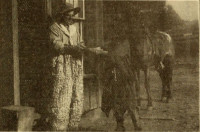The Cowboy and the Squaw Filming Locations

Where was The Cowboy and the Squaw filmed? The Cowboy and the Squaw was filmed in 2 locations across United States in the following places:
The Cowboy and the Squaw Filming Locations
El Paso is a city in and the county seat of El Paso County, Texas, United States. The 2020 population of the city from the U.S. Census Bureau was 678,815, making it the 22nd-most populous city in the U.S., the most populous city in West Texas, and the sixth-most populous city in Texas.
Santa Barbara is a city on the central California coast, with the Santa Ynez Mountains as dramatic backdrop. Downtown, Mediterranean-style white stucco buildings with red-tile roofs reflect the city’s Spanish colonial heritage. Upscale boutiques and restaurants offering local wines and seasonal fare line State Street. On a nearby hill, Mission Santa Barbara, founded in 1786, houses Franciscan friars and a museum.
The Cowboy and the Squaw (1910)
Tom Ripley, a cowpuncher from the Circle A ranch, wins the hatred of Jim Simpson, another cowpuncher, when he defends Lightfeather, a pretty squaw, from the insults of Simpson. The affair occurs in the Silver Dollar saloon in Bisbee. Some few days later Lightfeather goes to her protector's cabin and presents him with a pair of fine moccasins. Tom is duly grateful and advises the little Indian maiden that if she is ever annoyed again, not to hesitate to shoot the persecutor. Not long after this meeting Simpson encounters Ripley out on the range on the brink of a precipice. A fight ensues in which Ripley is thrown over the cliff and frightfully wounded on the rocks below. Ripley's riderless horse gallops away and is later seen and recognized by Lightfeather. The squaw mounts the horse and follows the tracks back to the top of the cliff where she finds her good white friend. After much difficulty she assists him back to the cabin and cares for him in his convalescence. Simpson, who has vowed to "get" Ripley at any cost, watches Tom's cabin day and night but the wary Lightfeather has seen him skulking about and keeps a sharp lookout after Tom. Later when she sees Simpson slipping threateningly on Ripley and about to fire at him, she draws her own weapon and a timely shot kills the would-be murderer. Ripley turns to find Simpson lying dead, just behind him, when the little squaw comes from behind her hiding place in the nearby bushes, confessing that she had killed Simpson to save him. Ripley brings up his horse and swinging into the saddle, pulls the squaw up behind him, just as a party of cowboys, who have heard the shot, run upon the scene. A lively chase follows. By numerous tricks Ripley throws his pursuers off the trail and after a long ride draws rein at a little creek, the boundary line of two counties. When he crosses this he knows he will be safe from the sheriff, at least. Pulling a notebook from his pocket Ripley scribbles a line to the sheriff, which be ties to a weed at the water's edge. Some time later the sheriff and his posse arrive at the crossing and find the note. It reads: "Buck Brady, Sheriff: We have crossed the boundary line forever. Good-bye. The squaw only killed a cur, and you know it. Tom Ripley." The sheriff reads the note aloud and turns to his men. "Tom's right," he says, "that Simpson was never no account, nohow." And the little party of cowboys swing leisurely into their saddles and turn their horses' heads toward home.
